247 scholarly books by University Press of New England and 12
have author last names that start with F
247 scholarly books by University Press of New England and 12
247 scholarly books by University Press of New England
12 have author last names that start with F have author last names that start with F
12 have author last names that start with F have author last names that start with F
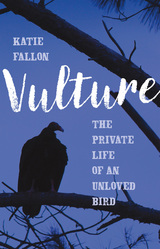
Katie Fallon
University Press of New England
Turkey vultures, the most widely distributed and abundant scavenging birds of prey on the planet, are found from central Canada to the southern tip of Argentina, and nearly everywhere in between. In the United States we sometimes call them buzzards; in parts of Mexico the name is aura cabecirroja, in Uruguay jote cabeza colorada, and in Ecuador gallinazo aura. A huge bird, the turkey vulture is a familiar sight from culture to culture, in both hemispheres. But despite being ubiquitous and recognizable, the turkey vulture has never had a book of literary nonfiction devoted to it—until Vulture. Floating on six-foot wings, turkey vultures use their keen senses of smell and sight to locate carrion. Unlike their cousin the black vulture, turkey vultures do not kill weak or dying animals; instead, they cleanse, purify, and renew the environment by clearing it of decaying carcasses, thus slowing the spread of such dangerous pathogens as anthrax, rabies, and botulism. The beauty, grace, and important role of these birds in the ecosystem notwithstanding, turkey vultures are maligned and underappreciated; they have been accused of spreading disease and killing livestock, neither of which has ever been substantiated. Although turkey vultures are protected under the Migratory Bird Treaty Act, which makes harming them a federal offense, the birds still face persecution. They’ve been killed because of their looks, their odor, and their presence in proximity to humans. Even the federal government occasionally sanctions “roost dispersals,” which involve the harassment and sometimes the murder of communally roosting vultures during the cold winter months. Vulture follows a year in the life of a typical North American turkey vulture. By incorporating information from scientific papers and articles, as well as interviews with world-renowned raptor and vulture experts, author Katie Fallon examines all aspects of the bird’s natural history: breeding, incubating eggs, raising chicks, migrating, and roosting. After reading this book you will never look at a vulture in the same way again.
[more]
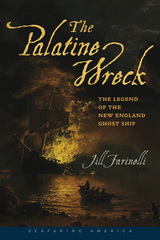
The Palatine Wreck
The Legend of the New England Ghost Ship
Jill Farinelli
University Press of New England, 2017
Two days after Christmas in 1738, a British merchant ship traveling from Rotterdam to Philadelphia grounded in a blizzard on the northern tip of Block Island, twelve miles off the Rhode Island coast. The ship carried emigrants from the Palatinate and its neighboring territories in what is now southwest Germany. The 105 passengers and crew on board—sick, frozen, and starving—were all that remained of the 340 men, women, and children who had left their homeland the previous spring. They now found themselves castaways, on the verge of death, and at the mercy of a community of strangers whose language they did not speak. Shortly after the wreck, rumors began to circulate that the passengers had been mistreated by the ship’s crew and by some of the islanders. The stories persisted, transforming over time as stories do and, in less than a hundred years, two terrifying versions of the event had emerged. In one account, the crew murdered the captain, extorted money from the passengers by prolonging the voyage and withholding food, then abandoned ship. In the other, the islanders lured the ship ashore with a false signal light, then murdered and robbed all on board. Some claimed the ship was set ablaze to hide evidence of these crimes, their stories fueled by reports of a fiery ghost ship first seen drifting in Block Island Sound on the one-year anniversary of the wreck. These tales became known as the legend of the Palatine, the name given to the ship in later years, when its original name had been long forgotten. The flaming apparition was nicknamed the Palatine Light. The eerie phenomenon has been witnessed by hundreds of people over the centuries, and numerous scientific theories have been offered as to its origin. Its continued reappearances, along with the attention of some of nineteenth-century America’s most notable writers—among them Richard Henry Dana Sr., John Greenleaf Whittier, Edward Everett Hale, and Thomas Wentworth Higginson—has helped keep the legend alive. This despite evidence that the vessel, whose actual name was the Princess Augusta, was never abandoned, lured ashore, or destroyed by fire. So how did the rumors begin? What really happened to the Princess Augusta and the passengers she carried on her final, fatal voyage? Through years of painstaking research, Jill Farinelli reconstructs the origins of one of New England’s most chilling maritime mysteries.
[more]
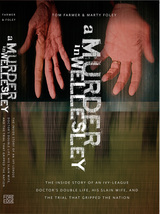
A Murder in Wellesley
The Inside Story of an Ivy-League Doctor’s Double Life, His Slain Wife, and the Trial That Gripped the Nation
Tom Farmer
University Press of New England, 2017
On Halloween morning in 1999, Mabel Greineder was savagely murdered along a wooded trail in the well-heeled community of Wellesley, Massachusetts. As the shock following the brutal killing slowly subsided, the community was further shaken when the focus of the investigation turned to her husband, Dirk Greineder, a prominent physician and family man who was soon revealed to be leading a secret double life involving prostitutes, pornography, and trysts solicited through the Internet. A Murder in Wellesley takes the reader far beyond the headlines and national news coverage spawned by “May” Greineder’s killing and tells the untold story of the meticulous investigation led by Marty Foley, the lead State Police detective on the case, from the morning of the murder through Dirk Greineder’s ultimate conviction. Exhaustive interviews with key figures in the case, including many who have not talked publicly until now, contribute to an unprecedented behind-the-scenes account of how investigators methodically built their case against Greineder and how the sides taken by Dirk and May’s relatives aided the investigation but bitterly divided their families. A fascinating true-crime procedural that is also a deeply unsettling tale of the psychopath you thought you knew, of deceptions and double lives, and of families torn apart by an unthinkable crime. Culminating in one of the most dramatic courtroom spectacles in recent memory (aired nationally on Court TV), A Murder in Wellesley reveals the truth behind the murder that gripped a nation.
[more]
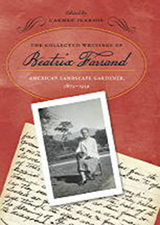
Beatrix Farrand
University Press of New England
Beatrix Jones Farrand (1872–1959) was among the first professional American women landscape gardeners. One of the founding eleven members of the American Society of Landscape Architects, Farrand believed in using native plant materials to connect the natural and designed landscape. Her papers are archived at the University of California, Berkeley, and Harvard’s Arnold Arboretum. This volume offers a print version of most of her written work, which includes her gardening diary and a wide selection of essays. The volume also contains a bibliography of additional materials.
[more]
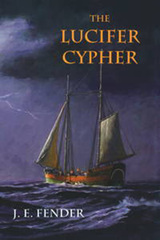
The Lucifer Cypher
J. E. Fender
University Press of New England, 2012
Geoffrey Frost, American sea captain and veteran of the China Trade, and Ming Tsun, his enigmatic mute friend, return in this latest installment of the highly literate and compelling saga of the American struggle for independence at sea. After a clash against well-armed British warships, Frost’s ship, the privateer Audacity, must be laid up for repairs. Frost, however, is not the kind of man to sit idle for long, and when a new secret weapon invented by David Bushnell comes to light, he recognizes a rare opportunity to strike hard at the complacent English. Commanding the prototype submarine Narwhal, Frost and the freed slave Darius set out to bring terror from below, all the while narrowly avoiding sinking and certain death in the cast iron tomb. J. E. Fender proves in this harrowing novel of power and suspense why he is quickly distinguishing himself as one of the eminent voices of American historical fiction.
[more]
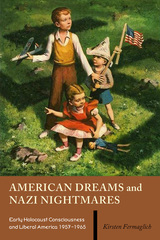
American Dreams and Nazi Nightmares
Early Holocaust Consciousness and Liberal America, 1957-1965
Kirsten Fermaglich
University Press of New England, 2007
To a great extent, Holocaust consciousness in the contemporary United States has become intertwined with American Jewish identity and with support for right-wing Israeli politics -- but this was not always the case. In this illuminating study, Kirsten Fermaglich demonstrates that in the late 1950s and early 1960s, many American Jewish writers and academics viewed the Nazi extermination of European Jewry as a subject of universal interest, with important lessons to be learned for the liberal reform of American politics. Fermaglich analyzes the lives and writings of Stanley M. Elkins, Betty Friedan, Stanley Milgram, and Robert Jay Lifton, four social scientific thinkers whose work was shaped by a liberal perspective. For them, the Holocaust served as a critical frame of reference for a particular issue: Elkins on slavery's legacy, Friedan on the oppressions of domesticity, Milgram on the willingness to obey, and Lifton on war's survivors. In each case, these thinkers were deeply influenced by their Jewish backgrounds, whether by early encounters with antisemitism or by the profound sense that only fate and an ocean had spared them death in Hitler's Europe. Thus, each chose imagery from the concentration camps, albeit utterly devoid of a particular Jewish association, to illuminate themes that advanced liberal politics, including civil rights, the nuclear test ban, feminism, and Vietnam veterans' rights. Rather than being offended by these authors' comparisons between American institutions and Nazi concentration camps, American audiences of all ethnic and religious backgrounds during the late 1950s and early 1960s generally cheered these authors' Nazi imagery and adopted it as part of their own political ideology. Fermaglich demonstrates that liberalism in the United States in the 1960s was more substantially shaped by the Holocaust than we have previously recognized.
[more]
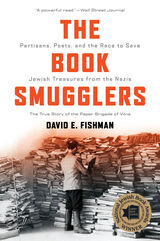
The Book Smugglers
Partisans, Poets, and the Race to Save Jewish Treasures from the Nazis
David E. Fishman
University Press of New England, 2018
The Book Smugglers is the nearly unbelievable story of ghetto residents who rescued thousands of rare books and manuscripts—first from the Nazis and then from the Soviets—by hiding them on their bodies, burying them in bunkers, and smuggling them across borders. It is a tale of heroism and resistance, of friendship and romance, and of unwavering devotion—including the readiness to risk one’s life—to literature and art. And it is entirely true. Based on Jewish, German, and Soviet documents, including diaries, letters, memoirs, and the author’s interviews with several of the story’s participants, The Book Smugglers chronicles the daring activities of a group of poets turned partisans and scholars turned smugglers in Vilna, “The Jerusalem of Lithuania.” The rescuers were pitted against Johannes Pohl, a Nazi “expert” on the Jews, who had been dispatched to Vilna by the Nazi looting agency, Einsatzstab Reichsleiter Rosenberg, to organize the seizure of the city’s great collections of Jewish books. Pohl and his Einsatzstab staff planned to ship the most valuable materials to Germany and incinerate the rest. The Germans used forty ghetto inmates as slave-laborers to sort, select, pack, and transport the materials, either to Germany or to nearby paper mills. This group, nicknamed “the Paper Brigade,” and informally led by poet Shmerke Kaczerginski, a garrulous, street-smart adventurer and master of deception, smuggled thousands of books and manuscripts past German guards. If caught, the men would have faced death by firing squad at Ponar, the mass-murder site outside of Vilna. To store the rescued manuscripts, poet Abraham Sutzkever helped build an underground book-bunker sixty feet beneath the Vilna ghetto. Kaczerginski smuggled weapons as well, using the group’s worksite, the former building of the Yiddish Scientific Institute, to purchase arms for the ghetto’s secret partisan organization. All the while, both men wrote poetry that was recited and sung by the fast-dwindling population of ghetto inhabitants. With the Soviet “liberation” of Vilna (now known as Vilnius), the Paper Brigade thought themselves and their precious cultural treasures saved—only to learn that their new masters were no more welcoming toward Jewish culture than the old, and the books must now be smuggled out of the USSR. Thoroughly researched by the foremost scholar of the Vilna Ghetto—a writer of exceptional daring, style, and reach—The Book Smugglers is an epic story of human heroism, a little-known tale from the blackest days of the war.
[more]
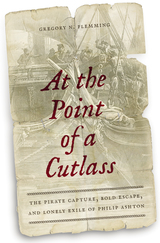
At the Point of a Cutlass
The Pirate Capture, Bold Escape, and Lonely Exile of Philip Ashton
Gregory N. Flemming
University Press of New England, 2015
A handful of sea stories define the American maritime narrative. Stories of whaling, fishing, exploration, naval adventure, and piracy have always captured our imaginations, and the most colorful of these are the tales of piracy. Called America’s real-life Robinson Crusoe, the true story of Philip Ashton—a nineteen-year-old fisherman captured by pirates, impressed as a crewman, subjected to torture and hardship, who eventually escaped and lived as a castaway and scavenger on a deserted island in the Caribbean—was at one time as well known as the tales of Cooper, Hawthorne, and Defoe. Based on a rare copy of Ashton’s 1725 account, Gregory N. Flemming’s vivid portrait recounts this maritime world during the golden age of piracy. Fishing vessels and merchantmen plied the coastal waters and crisscrossed the Atlantic and Caribbean. It was a hard, dangerous life, made more so by both the depredations and temptations of piracy. Chased by the British Royal Navy, blown out of the water or summarily hung when caught, pirate captains such as Edward Low kidnapped, cajoled, beat, and bribed men like Ashton into the rich—but also vile, brutal, and often short—life of the pirate. In the tradition of Nathaniel Philbrick, At the Point of a Cutlass expands on a lost classic narrative of America and the sea, and brings to life a forgotten world of ships and men on both sides of maritime law.
[more]
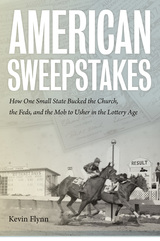
American Sweepstakes
How One Small State Bucked the Church, the Feds, and the Mob to Usher in the Lottery Age
Kevin Flynn
University Press of New England, 2015
By 1963 public lotteries—a time-honored if tarnished method of raising revenue for everything from the Roman roads to Washington’s Continental Army—had been outlawed in the United States for seventy years. The only legal gambling in America was found in Nevada, where mob involvement had at first been an open secret, and then revealed as no secret at all. In New Hampshire—a conservative, rural state with no sales tax and persistent problems with funding education—state legislator Larry Pickett had filed a bill to establish a lottery in every legislative session since 1953. To the surprise of many, it won passage a decade later and was signed into law by John King, the state’s first Democratic governor in forty years. American Sweepstakes describes how King assembled an unlikely group of supporters—including a celebrated FBI agent and the staunchly conservative publisher of the state’s leading newspaper—to establish the first state lottery in the nation, paving the way for what is today a $78 billion enterprise. Despite the remonstrations of the Catholic Church, the threat of arrest by the federal government, the strident denunciations of nearly every newspaper editorialist in the country, and the very real fear that the lottery would be co-opted by the mob, eleven thoroughbred racehorses leapt from the gate on September 12, 1964, in the first New Hampshire Sweepstakes, ushering in the lottery age in America.
[more]
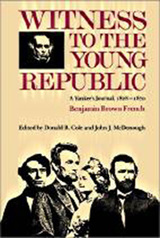
Witness to the Young Republic
A Yankee’s Journal, 1828–1870
Benjamin Brown. French
University Press of New England, 2002
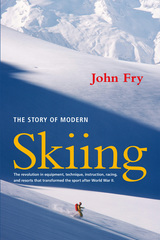
The Story of Modern Skiing
John Fry
University Press of New England, 2010
This is the definitive history of the sport that has exhilarated and infatuated about 30 million Americans and Canadians over the course of the last fifty years. Consummate insider John Fry chronicles the rise of a ski culture and every aspect of the sport’s development, including the emergence of the mega-resort and advances in equipment, technique, instruction, and competition. The Story of Modern Skiing is laced with revelations from the author’s personal relationships with skiing greats such as triple Olympic gold medalists Toni Sailer and Jean-Claude Killy, double gold medalist and environmental champion Andrea Mead Lawrence, first women’s World Cup winner Nancy Greene, World Alpine champion Billy Kidd, Sarajevo gold and silver medalists Phil and Steve Mahre, and industry pioneers such as Vail founder Pete Seibert, metal ski designer Howard Head, and plastic boot inventor Bob Lange. Fry writes authoritatively of alpine skiing in North America and Europe, of Nordic skiing, and of newer variations in the sport: freestyle skiing, snowboarding, and extreme skiing. He looks closely at skiing’s relationship to the environment, its portrayal in the media, and its response to social and economic change. Maps locating major resorts, records of ski champions, and a timeline, bibliography, glossary, and index of names and places make this the definitive work on modern skiing. Skiers of all ages and abilities will revel in this lively tale of their sport’s heritage.
[more]
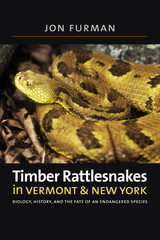
Timber Rattlesnakes in Vermont & New York
Biology, History, and the Fate of an Endangered Species
Jon Furman
University Press of New England, 2007
Today, small populations of timber rattlesnakes (Crotalus horridus) quietly inhabit parts of Rutland County in Vermont, and Warren, Washington, and Essex counties in New York. Because the species is endangered, the exact locations of established dens in this area are a closely guarded secret. Insider, naturalist, and author Jon Furman has devoted years to the study of the snake’s past and present range, its habitat and biology, the period in Vermont and upstate New York history during which timber rattlesnakes were ruthlessly hunted for a bounty, and the outlook for this severely threatened species in both states. Soundly anchored in the latest scientific data, Furman proffers an accessible and engaging account of contemporary fieldwork and first-person interviews with herpetologists and old-time bounty hunters. For expert and lay readers interested in snakes and reptiles, northeastern fauna and natural history, conservation, and endangered species, this volume clearly explicates the timber rattlesnake’s biology as well as what happens and what to do when one bites. It also explores the troubling decline of the northeastern population caused by bounty hunting between the 1890s and the early 1970s, other past and present threats to the species’ survival, and what measures are being taken—and additional ones that must be taken—to ensure that timber rattlesnakes survive and thrive in the northeast. Historical and contemporary illustrations bring these reptiles and their world to life. Timber Rattlesnakes in Vermont & New York shines a new light on a maligned and misunderstood species.
[more]
READERS
Browse our collection.
PUBLISHERS
See BiblioVault's publisher services.
STUDENT SERVICES
Files for college accessibility offices.
UChicago Accessibility Resources
home | accessibility | search | about | contact us
BiblioVault ® 2001 - 2024
The University of Chicago Press









